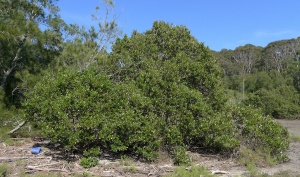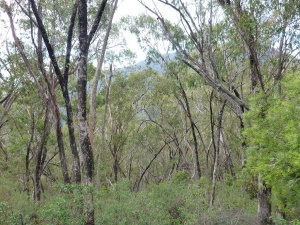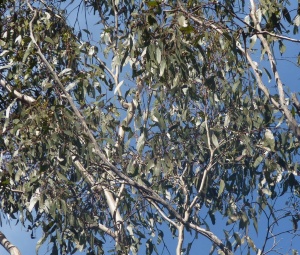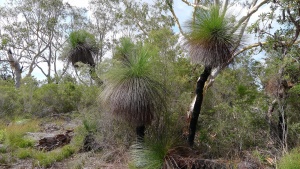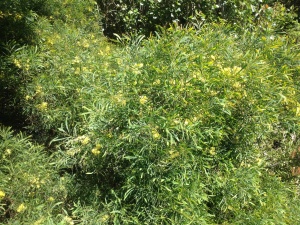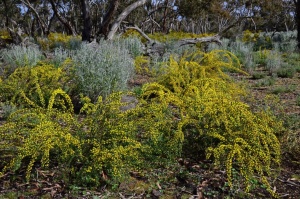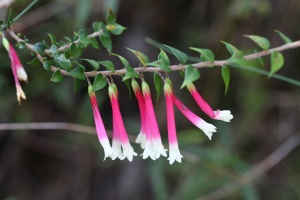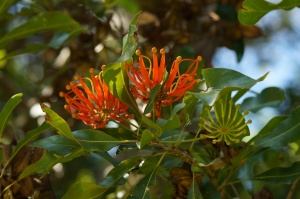Jen Sutfin
Gymea Lily
Giant tussock-like, rosette plant. Grows up to 2.5 m high with a flower stalk up to 5 m high!
Its genus name Doryanthes (meaning spear and flower), and its species name excelsa (meaning high), both refer to its tall flower stem.
Leaves
Long, sword-shaped and forming a clump. Each individual leaf is 1 – 2.5 m long and about 10 cm wide. Shorter leaves up to 30 cm long are found along the flower stem.
Flowers
Located at the top of a single flower stem which grows from the centre of the tussock of leaves. The stem is 2 – 5 m high upon which the flowers form a cluster up to 70 cm in diameter. The individual flowers are bright red (or rarely white), trumpet-shaped and 10 – 16 cm long.
Grey Mangrove
Large to small tree or shrub up to 25 m high (commonly around 5 m), branches, flower heads and lower surface of leaves greyish or silvery
Pneumatophores (erect, pencil-like aerial roots specialised for gaseous exchange) are numerous and project from shallow lateral roots.
Leaves
Leathery and measure up to 16 cm in length and 5 cm in width. They are ovate, pointed and arranged opposite one another on the stems. The leaves are glossy green above with a distinctive pale and slightly hairy, grey underside. Stomata (pores) and salt glands are scattered over the entire leaf surface but are more abundant on the underside. Leaves are often covered in crusted salt from the exuded secretions.
Flowers
Yellow-orange or golden. Flower clusters dense, arranged at leafy shoot tips; flower stalks 10 – 30 mm long. Flower 4 - 8 mm long with a corolla of four fused pointed petals 3 - 7 mm wide.
Grey Box NSW QLD
Also known as Gum-topped Box. Tree to 25 m high.
Bark is rough on part or all of trunk, thin, box-type or tessellated (mosaic-like), grey or mottled with grey and white patches; smooth bark white, cream or pale-grey, often shiny.
Leaves
Adult leaves alternate, broadly lance-shaped, 7 - 17 cm long, 2 - 5 cm wide, green, glossy, concolorous (both sides of the leaf blade are the same colour).
Flowers
White and usually clustered in groups of 7. Sometimes there are more than 7 or there may appear to be less as flowers have dropped off. They occur in multiple groups at the end of small branches.
Flower buds are ovate (egg-shaped) to fusiform (spindle shaped; tapering at both ends), 5 - 9 m long, 3 - 4 mm diameter; scar absent.
Grey Box
Medium-sized tree with long ascending branches forming a fairly large crown, grey fibrous bark on the lower branches and trunk. The upper branches have a smooth grey coloured bark. Commonly grows to 10 - 25 m tall.
Leaves
Juvenile leaves petiolate (a stalk that joins a leaf to a stem), are dull green, oval, usually 15 cm long and 5 cm wide. Adult leaves are narrow oval shape tapering to a point at each end, usually 8 – 15 cm long and 1 – 2 cm wide, clustered and dull green.
Flowers
The flower buds have cone-like caps. Flowers are cream to white which appear in late summer to winter (February to June).
Grass-tree
A reference to its yellow resin, Xanthorrhoea literally means "yellow flow" in Ancient Greek. Grass-tree is a misnomer. Its not a grass, nor a tree.They are actually distantly related to lilies.
Perennial flowering plant. Trunk resembles a tree above ground or exists under the earth’s surface. Trunk is woody and made up of tiny packed leaves.
Leaves
Clustered in a terminal crown, 30 - 140 cm long, rhombic (kite-shaped) to wedge-shaped in cross-section, tapering at the ends.
Flowers
Borne as flower clusters on a cylindrical and spike-like woody axis.
In the bush the flowers could reveal directions, since flowers on the warmer, sunnier side (usually north) of the spike often open before the flowers on the cooler side facing away from the sun.
Golden Wattle
The species name pycnantha from the Greek (pyknos) meaning dense, and (anthos) meaning a flower, refers to the dense clusters of flowers.
Small shrub or tree. Usually 3 - 8 m high.
Leaves
Has phyllodes (flattened leaf stalks) that are pinnate (arranged opposite each other on either side of the stem) and sickle-shaped 9 - 15 cm long and 1 - 3.5 cm wide; branchlets on leaves are hairy, sometimes covered in white powdery granules.
Flowers
Bright golden and sometimes lemon-yellow ball-shaped inflorescences (clusters flowers arranged on a stem). Flowers appear in late winter and spring and into early summer (July to November).
Gold-Dust Wattle
Bushy or straggly shrub, branchlets more or less angled at extremities, smooth or hairy. Bark is smooth, grey to brown. Commonly grows to 2.5 m high.
Leaves
Has phyllodes (flattened leaf stalks) that are rounded, usually asymmetric 0.4 – 1.5 cm long and 2 – 8 mm wide, hairy or smooth. Leaf midrib (large midline vein) is obscure or absent, lateral veins also absent.
Flowers
Bright yellow ball-shaped inflorescences (clusters flowers arranged on a stem) that form in patterns of 5. Flowers appear in late winter and spring and into early summer (July to November).
Fuchsia Heath
Its genus name Epicris means upon (epi) and a summit (acris), referring to the altitude where some species occur; and its species name longiflora means long (longus) and flower (florus), referring to the long, narrow flowers.
An upright to spreading evergreen shrub, typically straggly with branches arching towards the ground, 0.5 – 2 m high.
Leaves
With pointed tip and wide base, they are often described as heart-shaped. Each leaf is 5 – 17 mm long, 3 – 6.6 mm wide, and has slightly serrated margins. It is thin, flat, and sometimes has a rough upper surface.
Flowers
Long and tubular, some have pink-red tubes and white lobes (tips), others are all white. They are 5 – 6 mm in diameter and 12 – 27 mm long, with the lobes being 2.4 – 4.4 mm long. They grow in rows along the branches and are upright at first and then hang down as they reach maturity.
Firewheel Tree
Its genus name Stenocarpus means narrow fruit, referring to its seed pods; and its species name sinuatus means wavy, referring to the edges of the leaves.
Evergreen tree, up to 35 m high, but much smaller when grown in gardens where it reaches a height of only about 10 m with a width of 5 m.
Leaves
Dark glossy green and paler underneath, they can be oval-shaped, lobed or have wavy edges. They are usually 15 – 25 cm long (but can be up to 45 cm long) and 2 – 5 cm wide, and are generally smaller on exposed branches. There is one distinct vein running down the centre of each leaf.
Flowers
Bright red with a yellow tip, and 2.5 – 4 cm long. They cluster in a wheel-like arrangement at the end of a stalk. The cluster can be up to 10 cm in diameter and consists of 6 - 20 flowers.
Fagus
Often called Deciduous Beech, it is Australia’s only cold-deciduous woody plant. The wiry tangled growth of its branches give it another common name, Tanglefoot.
A dense shrub. Usually 1 - 3 m tall and wide, with spreading branches. It sometimes grows as a small tree in rainforest. Bark smooth and grey.
Leaves
Arranged alternately along stems, on short stalks. Individual leaves are rounded in outline with lobed margins; distinct grooves follow the leaf veins making the veins prominent on the lower side. Leaves are 10 - 20 mm long, bright to mid-green, paler on the under surface, turning yellow then orange or red in autumn. Leaves are absent during Winter. New leaves unfold from buds in a concertina fashion in spring.
Flowers
Separate male and female flowers, small and inconspicuous, and appear in late summer and early autumn.


